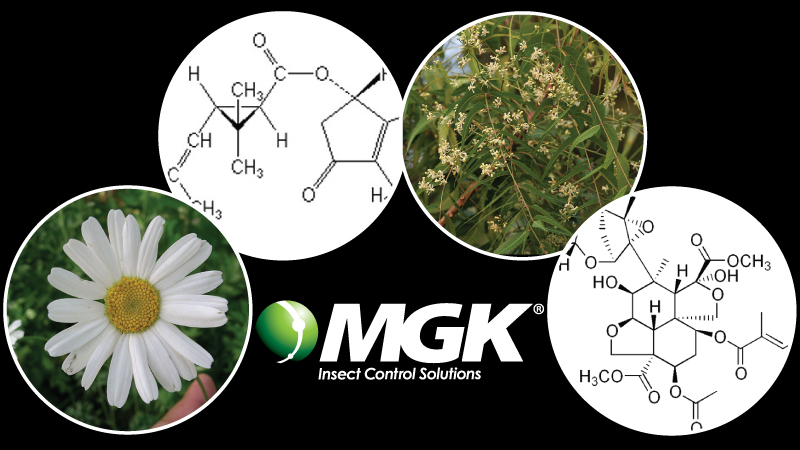Pyrethrum and Azadirachtin: What are they and how do they work?
First let’s talk about pyrethrum. Pyrethrum is the extract of certain species of chrysanthemum flowers. The species that modern pyrethrum is extracted from today is Chrysanthemum cinerariifolium, although other species have been used in the past. It has white petals and looks a lot like a daisy. Once the flowers are harvested they are dried and then crushed in to powder. Good quality flowers will contain 1.4% to 1.8% pyrethrins according to http://www.pyrethrum.com/About_Pyrethrum/Processing.html. The first extraction results in a dark, tarry looking substance. Further extraction is done to remove other plant residues like vegetable waxes, resins, and colors that could potentially stain surfaces. After refining the extract into a clear to amber liquid it is then formulated into the products you use such as PyGanic®, Evergreen Pro 60-6®, and many others.

The Chrysanthemum cinerariifolium Flower
Pyrethrum contains 6 esters, collectively called pyrethrins. Each of the 6 esters has efficacy against insects, acting on the nervous system, but each acts in a slightly different way from the others. This has been theorized, but not proven, to help reduce the risk of insect resistance development. Pyrethrins certainly aren’t immune to resistance development though. Remember to rotate pyrethrum with products based on different modes of action. Pyrethrins and pyrethroids are classified as group 3A on the Insecticide Resistance Action Committee (IRAC) http://www.irac-online.org/modes-of-action/.

Pyrethrin I Structural Formula
How do pyrethrins kill the insect? Pyrethrins are sodium channel modulators. They bind to the sodium channels along the nerve and disrupt normal transmissions of the nerves. The insects lose function of their nervous systems and die rapidly from those effects. Synthetic pyrethroids, whose chemistries are based on the naturally occurring pyrethrins, have the same type of interactions and are in the same mode of action grouping as pyrethrins.

Pyrethrins Mode of Action
Insects do have a detoxification system to deal with these toxins in their environment and break them down inside the insect. That is why insects that get a sub-lethal dose of pyrethrins can be knocked down and look like they are on their way to dying, but then eventually recover and walk away. Getting good coverage and making sure the correct concentration of insecticide is sprayed is very important for this reason.
Now let’s talk about azadirachtin. Azadirachtin is an extract from the neem tree, Azadirachta indica. It is in the mahogany family Meliaceae. It is a large evergreen that can grow up to around 65 feet tall. The seeds of the neem tree are where the insecticidal extract comes from. The seeds contain about 0.5% azadirachtin by weight. The seed also contains about 20 to 30% oil, which has to be separated out also, and is used as an insecticidal product itself. The azadirachtin and oil do not mix together well. First the oil is pressed out of the seed and then the azadirachtin is extracted with an alcohol from the pressed seed cake. The alcohol solvent is then mostly or entirely evaporated away to leave a powdered, concentrated azadirachtin product which is used in formulating insecticides.

The Neem Tree (Azadirachta indica)
Azadirachtin on the IRAC website http://www.irac-online.org/modes-of-action/ is classified as “unknown or non-specific” mode of action. Compounds can have this classification if the target site is not well described, or if the exact functions are not specifically known. It can also be classified as unknown if the compound acts non-specifically on multiple target sites. There are some things we do know about azadirachtin’s mode of action though. We know that it often has an antifeedant effect on insects, causing them to stop eating. This is of utmost importance in plant protection as often the damage is done by the insect feeding on the plant so an end to the feeding damage is exactly what growers want. Azadirachtin also has an Insect Growth Regulator (IGR) effect where molting is inhibited and fertility is reduced. Lack of future progeny is especially important in populations with multiple generations per year, such as aphids. The mode of action has been described by some as “insectistatic”. To a grower, if azadirachtin is the only product applied, it can look as if it isn’t working. The insects are still alive and present, but stop feeding, developing, growing, and reproducing.

Azadirachtin Structural Formula
Feeding inhibition can be seen in several hours, then the IGR effect can be seen in days or weeks with lack of molting and reproduction. Azadirachtin does not have a knock-down effect like pyrethrins do and it is a much more subtle mode of action. When using azadirachtin on its own, a grower may not have dead insects immediately evident, and will need to monitor to make sure the population is being controlled sufficiently.
Feeding inhibition seems to be strongest in lepidopterans and can result in mortality by starvation. Other insects can also be affected by azadirachtin in a complex manner that is difficult to predict, but ranging from feeding inhibition to various severities of reproductive interference.
The power of the one-two punch. The benefits of combining more than one active ingredient in a botanically-derived insecticide product to achieve multiple modes of action is very powerful, such as in MGK’s Azera® Gardening (for home garden users) and Azera® Pro (for professional users) OMRI-Listed botanical insecticide, which combines azadirachtin with pyrethrins. With Azera® Gardening and Azera® Pro, growers and gardeners can benefit from the rapid knock down and kill that is achieved with the use of pyrethrins, as well as the subtler yet lingering effects of the azadirachtin for any pest insect species, populations, or individuals who are able to survive the initial treatment.
Article by: Sandra Sleezer
MGK – Technical Service Coordinator
July 19, 2018







